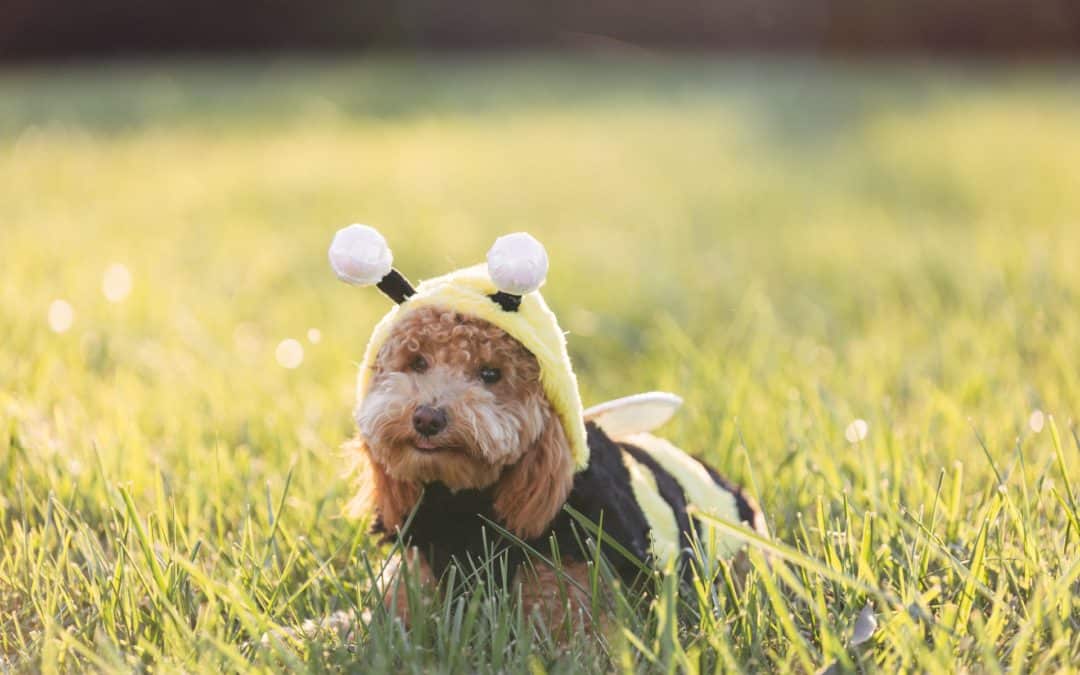Dogs are naturally curious and playful, and they often stick their noses where they don’t belong. But if your pup bites or paws at a busy bee, or goes exploring a little too close to a hive, they could get stung.
Although bee stings usually aren’t life-threatening for dogs, they can still cause a good deal of discomfort as well as allergic reactions. Knowing what to do if your dog gets stung by a bee will help you stay calm, act quickly, and handle the situation effectively.
How to Tell If Your Dog Was Stung
If you didn’t actually see a bee sting your dog, it can be difficult to know what’s wrong. If your dog is acting upset, remember to check for symptoms of stings. Bee stings can cause the following symptoms in dogs:
- Biting at the place they were stung
- Limping
- Swelling
- Pawing at face
- Coughing or gagging
- Constantly licking lips
- Difficulty breathing
- Vomiting or diarrhea
- Drooling
- Whining
- Hives
What to Do If Your Dog Gets Stung by a Bee
If you do see your dog get stung by a bee, it’s crucial to stay calm and be prepared to keep a close eye on them for the whole day. While symptoms usually appear within 30-60 minutes after being stung, they can sometimes take hours to develop. That’s why it’s a good idea to always have a pet first-aid kit handy.
If your dog was stung, it’s normal for them to experience some swelling and minor discomfort. However, if your dog swallowed the bee or got stung inside the mouth, they may show more concerning symptoms.
Can Dogs Be Allergic to Bees?
An allergic reaction to a sting in the mouth or throat can cause swelling that blocks the airways, leading to coughing, wheezing, drooling, or gagging. And swallowing the bee could lead to vomiting or diarrhea, which can cause dehydration. See your emergency vet right away if you notice any of these symptoms.
No matter where your dog got stung, it’s always important to watch for signs of an allergic reaction. Weakness, hives anywhere on the body, and/or significant swelling that extends beyond the sting site can indicate an adverse reaction.
In rare cases, a severe allergic reaction can also lead to anaphylactic shock. Signs of this life-threatening reaction include:
- Pale gums
- Cold legs
- Seizures
- Drooling
- Coma
- Vomiting
- Diarrhea
Seek emergency veterinary care immediately if you suspect your dog is having any kind of allergic reaction.
How to Treat a Dog Bee Sting
1. Remove the Stinger
Bees leave their stingers in their victims, so they can continue to distribute venom and cause irritation for some time afterward. If you can see a stinger in the wound, carefully and gently remove it with tweezers. Just avoid using tweezers that have pointed tips, because they might squeeze more venom out of the stinger.
2. Apply a Soothing Paste
You can help relieve your dog’s pain after being stung by applying a soothing paste to the site—made by mixing 1 part baking soda with 1 part water. An oatmeal bath may be a better option if your dog has multiple stings.
3. Apply an Ice pack
Applying an ice pack wrapped in a soft towel for 10 minutes at a time will help reduce swelling. If your dog has multiple stings and large areas of swelling, a cool towel can help instead.
4. Prevent Scratching
It’s important to keep your dog from irritating the wound. Biting, licking, or scratching at the sting site can interfere with healing and may lead to infection. An anti-scratch recovery dog collar or a cone can help protect the wound while it heals.
5. Make Sure Your Dog Eats and Drinks
Your dog needs to stay hydrated and eat well in order to heal. Make sure that your dog drinks plenty of fresh water. If your dog was stung on the mouth, give them dry food softened with water to make it easier to eat, but avoid wet food. Although wet food is also easy to eat, it’s actually harder on the stomach.
Emergency Vet in Gilbert, Arizona
If you’re worried about your dog being stung by a bee, and wondering what to do, please don’t hesitate to contact us. The compassionate team at Anasazi Animal Clinic is trained to handle a wide range of veterinary emergencies, including bee stings.
If your dog was stung by a bee and may be having an adverse reaction, we can help. Call 480-497-0505 today to schedule an emergency appointment.
Images used under creative commons license – commercial use (7/3/2023). Photo by Josh Rocklage on Unsplash

